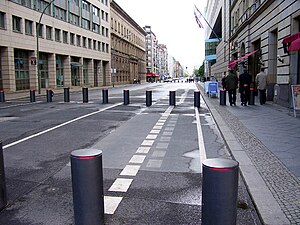| Revision as of 22:34, 21 August 2007 editPmanderson (talk | contribs)Autopatrolled, Extended confirmed users, Pending changes reviewers62,752 editsm clearly English usage for this sense.← Previous edit | Revision as of 19:06, 22 August 2007 edit undoPmanderson (talk | contribs)Autopatrolled, Extended confirmed users, Pending changes reviewers62,752 edits Mark nationalist monument; this is not what the street is called, and it is driven by a nationalist PoVNext edit → | ||
| Line 1: | Line 1: | ||
| {{totallydisputed}} | |||
| {{Foreignchar|ß|Wilhelmstrasse}} | {{Foreignchar|ß|Wilhelmstrasse}} | ||
| ] | ] | ||
Revision as of 19:06, 22 August 2007

The Wilhelmstraße is a street in the center of Berlin, the capital of Germany. Between the mid 19th century and 1945 it was the administrative centre first of the Kingdom of Prussia and then of the unified German state, housing in particular the Reich Chancellery and the Foreign Office. For this reason the term "the Wilhelmstrasse" was used to signify the German governmental administration as a whole, much as the term "Whitehall" is often used to signify the British governmental administration as a whole.
The Wilhelmstraße runs south from the Unter den Linden, on a line slightly east of south, until its juncture with Stresemannstraße near the Hallesches Ufer, a distance of about two kilometres. It is crossed (as one heads south) by Behrenstraße, Leipziger Straße and Zimmerstraße, which to the west of the Wilhelmstraße becomes Niederkirchnerstraße (known before World War II as Prinz-Albrecht-Straße).
A street along this line has existed since the early 18th century, and was known as Husarenstraße (Street of the Hussars) until 1740, when it, along with the Friedrichstraße, which runs roughly parallel to the east, were given their current names to commemorate Friedrich Wilhelm I of Prussia, who had done much to develop the area.
Originally a wealthy residential street, with a number of palaces belonging to members of the Prussian royal family, the Wilhelmstraße developed as a government precinct from the mid 19th century. From 1875 the Reich Chancellery building stood at Wilhelmstraße 77. During the years of the Weimar Republic (1919-33), the Reich President's official residence was at Wilhelmstraße 73. It was from the balcony of this building that Reich President Paul von Hindenburg watched the torchlight parade on the night the Nazis came to power: 30 January 1933.
In 1938-39 a new Reich Chancellery was built for Adolf Hitler by Albert Speer. This building stood immediately south of the old Chancellery, on the corner of Wilhelmstraße and Voßstraße, and its official address was Voßstraße 4, but the balcony from which Hitler addressed crowds faced the Wilhelmstraße. The square opposite the building, known as the Wilhelmplatz, no longer exists. Also vanished is the Kaiserhof Hotel, which stood a few doors away and had been Hitler's favoured residence in Berlin before he came to power.
During the Nazi era, the German Foreign Office was situated in the former Reich President's palace at Wilhelmstraße 73, the old building being refurbished in grandiose style by the Nazi Foreign Minister Joachim von Ribbentrop. The Finance Ministry stood at Wilhelmstraße 61. During the Nazi years Joseph Goebbels' Propaganda Ministry stood further south at Wilhelmstraße 8-9. The Agriculture Ministry stood at Wilhelmstraße 72, as it still does today - the only German government ministry now located on its prewar site, although in a reconstructed building. The British Embassy was at Wilhelmstraße 70. The original building was destroyed by bombing, and a new Embassy was built on the site after the reunification of Germany. Queen Elizabeth II officiated at the grand opening in July 2000.
The only major surviving public building on the Wilhelmstraße from the Nazi era is the Reich Air Ministry building at Wilhelmstraße 81-85, south of Leipziger Straße, a huge edifice built on the orders of Hermann Göring between 1933 and 1936. This building escaped major damage during the war. As one of the few intact government buildings in central Berlin, it was occupied by the Council of Ministers of the new German Democratic Republic in 1949. As such it was at the centre of the popular demonstrations during the workers' uprising of 17 June 1953.
Apart from the Air Ministry, all the major public buildings along the Wilhelmstraße were destroyed by Allied bombing during 1944 and early 1945. The Wilhelmstraße as far south as Zimmerstraße was in the Soviet Zone of occupation, and apart from clearing the rubble from the street little was done to reconstruct the area until the founding of the GDR in 1949. The communist GDR regime regarded the former government precinct as a relic of Prussian and Nazi militarism and imperialism, and had all the ruins of the government buildings demolished in the early 1950s. In the late 1950s there were almost no buildings at all along the Wilhelmstraße from the Unter den Linden to Leipziger Straße. In the 1980s, apartment blocks were built along this section of the street.
From 1964 to 1991, when the street as far south as Zimmerstraße was in the territory of the GDR, this section was named Otto-Grotewohl-Straße, after Otto Grotewohl, who was Prime Minister of the GDR from 1949 to 1964.
Today the Wilhelmstraße is an important traffic artery, but has not regained its former status. The Air Ministry building today houses the German Finance Ministry. This, the Agriculture Ministry and the British Embassy are the only public buildings on the street. Many of the occupants of the apartment blocks are recent immigrants, and there are a number of shops and restaurants catering to Russians and Turks.
In recent years the City of Berlin has placed a series of historical markers along the Wilhelmstraße, showing where the well-known buildings of the pre-war era stood.
External links
- Wilhelmstraße in Berlin online streep maps Template:De icon
- The Historical Wilhelmstraße Template:De icon
52°30′35″N 13°23′03″E / 52.50972°N 13.38417°E / 52.50972; 13.38417
Category: